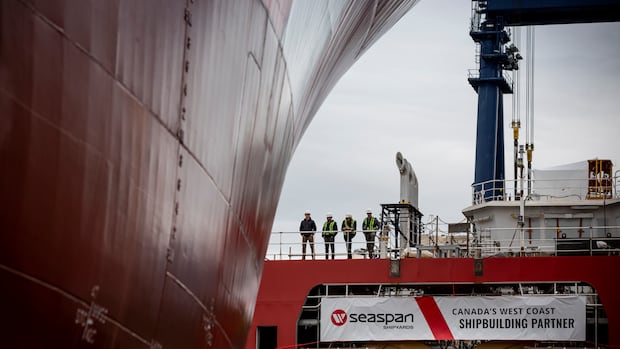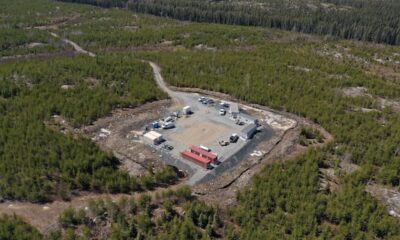Top Stories
B.C. Firms Set for Defence Boom as Ottawa Commits $6.6B Now

UPDATE: Canadian tech and shipbuilding firms in British Columbia are poised for a significant boom following Ottawa’s announcement of a staggering $6.6 billion defence investment over the next five years. This surge in funding is set to dramatically enhance shipbuilding and naval technology operations across the province as the federal government aims to meet NATO commitments.
Engineers and technicians at OSI Maritime Systems in Burnaby are already feeling the impact. The company, known for building advanced navigation systems for the Royal Canadian Navy and 25 other navies worldwide, is experiencing rapid growth. President Jim Sinclair stated, “Right now we’re at the pinnacle of a new era,” as the workforce has expanded from 265 to 400 employees in just three years.
The recent defence spending announcement is a direct response to NATO leaders’ call for member countries to increase military funding to 5% of GDP by 2035. Currently, Canada is projected to spend only 1.37% of GDP on defence in 2024. This shift signifies a pivotal moment for B.C., promising to stimulate the economy and create numerous high-paying jobs, according to Sinclair.
B.C. has developed a proactive strategy, called the Look West plan, aiming to secure 35% of federal defence vessel contracts by 2035. The province is collaborating with strategic partner Seaspan to ensure local companies benefit from this influx of funding. B.C. Jobs Minister Ravi Kahlon emphasized, “Billions of dollars are being invested. We want to make sure B.C. sees as many of those dollars as possible because it means good jobs in our communities.”
To strengthen its bid for these contracts, B.C. has enlisted the help of former federal defence minister Harjit Sajjan, who is volunteering his expertise to help guide local companies in competing for this unprecedented opportunity. Sajjan remarked, “We need to expand the opportunities… companies need to be bold to take advantage of it, because now you have all levels of government fully behind this growth.”
While the promise of increased federal investment is welcome news, it also comes amid controversy. B.C. Ferries recently awarded a contract to a Chinese state-owned shipyard for four new vessels, igniting backlash from local unions and industry groups who argue that the work should remain in Canada. Seaspan, which did not bid on the B.C. Ferries project, cited competitiveness issues against Chinese labor costs while fulfilling its commitments under the National Shipbuilding Strategy.
Despite these challenges, industry leaders believe that enhanced federal investment will reshape B.C.’s industrial landscape. Leo Martin, Seaspan’s senior vice-president of programs, noted that investment in skills training and infrastructure is crucial. “Investment into skills training and development… will put us in a fantastic position going forward,” he said.
Sinclair echoed this sentiment, emphasizing that the future of B.C.’s role in defence shipbuilding will hinge on workforce development. “The more investment they can make in training, the better,” he stated, underscoring the importance of research and development to build a ready workforce.
In a bid to meet the anticipated demand, B.C. has announced plans to double funding for trades training. This initiative is pivotal to ensuring that local companies are prepared to capitalize on the influx of defence dollars and secure the skilled workforce they need.
As this situation develops, stakeholders will be closely monitoring Ottawa’s spending strategies and their implications for British Columbia’s economy and employment landscape. The urgency surrounding these developments highlights a crucial moment for B.C. firms as they prepare to seize new opportunities in the defence sector.
-

 Politics2 weeks ago
Politics2 weeks agoSecwepemc First Nation Seeks Aboriginal Title Over Kamloops Area
-

 World4 months ago
World4 months agoScientists Unearth Ancient Antarctic Ice to Unlock Climate Secrets
-

 Entertainment4 months ago
Entertainment4 months agoTrump and McCormick to Announce $70 Billion Energy Investments
-

 Lifestyle4 months ago
Lifestyle4 months agoTransLink Launches Food Truck Program to Boost Revenue in Vancouver
-

 Science4 months ago
Science4 months agoFour Astronauts Return to Earth After International Space Station Mission
-

 Technology3 months ago
Technology3 months agoApple Notes Enhances Functionality with Markdown Support in macOS 26
-

 Top Stories1 month ago
Top Stories1 month agoUrgent Update: Fatal Crash on Highway 99 Claims Life of Pitt Meadows Man
-

 Sports4 months ago
Sports4 months agoSearch Underway for Missing Hunter Amid Hokkaido Bear Emergency
-

 Politics4 months ago
Politics4 months agoUkrainian Tennis Star Elina Svitolina Faces Death Threats Online
-

 Politics4 months ago
Politics4 months agoCarney Engages First Nations Leaders at Development Law Summit
-

 Lifestyle2 months ago
Lifestyle2 months agoManitoba’s Burger Champion Shines Again Amid Dining Innovations
-

 Technology4 months ago
Technology4 months agoFrosthaven Launches Early Access on July 31, 2025




















